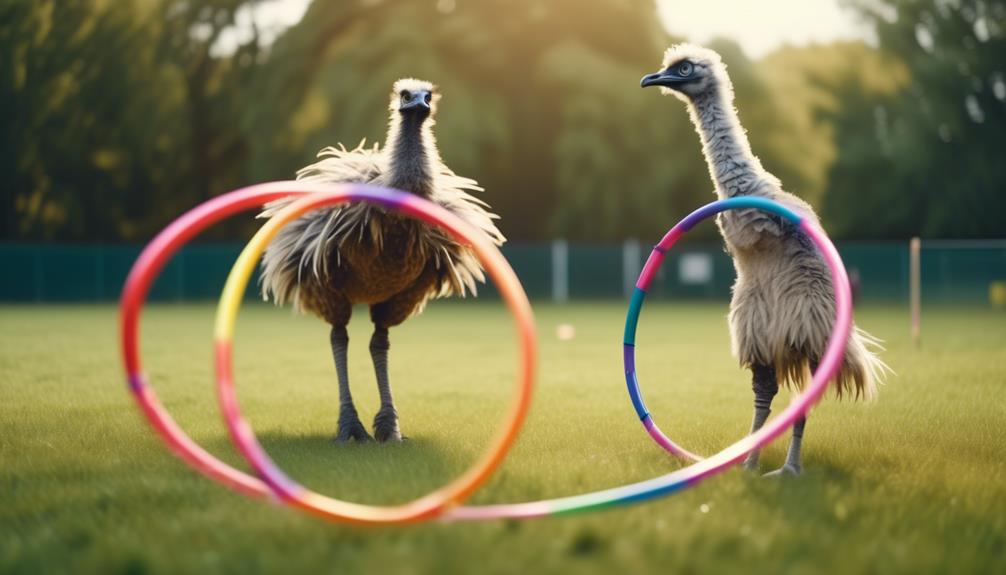
Are you ready to embark on a journey filled with feathers and fascinating challenges?
Training your emu can be compared to unlocking a hidden treasure chest, where the key lies in your understanding of their behavior.
But fear not, for this guide will equip you with effective techniques and strategies that will help you build trust, establish respect, and create a strong bond with your emu.
So, get ready to step into the world of emu training, as we explore the secrets to success and navigate through the twists and turns of this unique endeavor.
Understanding Emu Behavior

To effectively train your emu, it's crucial to first gain a deep understanding of their behavior. Emus have unique communication patterns that play a significant role in their social interactions. These patterns include vocalizations, body postures, and feather displays. By observing and interpreting these signals, you can better understand your emu's needs and emotions.
Emus are social animals that live in groups known as mobs. Within these mobs, a social hierarchy exists, with dominant individuals leading the group. Understanding the social hierarchy is essential when training your emu, as it helps establish yourself as the leader and gain their respect. By recognizing the dominant individuals and their behaviors, you can effectively navigate the social dynamics of your emu group.
Observing your emu's behavior in different contexts, such as feeding or mating, will provide valuable insights into their natural instincts and tendencies. This knowledge will allow you to tailor your training methods to suit their specific needs and preferences, enhancing the effectiveness of your training sessions.
Establishing Trust and Respect
Understanding the social hierarchy and behavioral patterns of emus is crucial in establishing trust and respect when training these animals. To build rapport and set boundaries with your emu, follow these effective techniques:
- Approach with confidence: Emus are highly perceptive and will respond positively to a calm and assertive demeanor. Maintain a relaxed posture and speak in a soothing yet firm tone to convey your leadership.
- Use positive reinforcement: Emus respond well to rewards and praise. When your emu displays desired behavior, such as following commands or remaining calm, reward it with treats or verbal affirmations. This will reinforce trust and encourage further cooperation.
- Consistency is key: Emus thrive on routine and structure. Establish clear rules and expectations from the beginning and consistently reinforce them. Emus will learn to trust and respect you when they understand the boundaries and consequences of their actions.
- Practice patience: Building trust takes time, especially with emus. Be patient and understanding as you work with your emu. Avoid rushing or forcing it into uncomfortable situations. Gradually introduce new experiences and gradually increase the level of difficulty in training exercises.
Positive Reinforcement Training Methods

Positive reinforcement training methods are highly effective in teaching emus desired behaviors and encouraging their cooperation. Two commonly used positive reinforcement techniques for training emus are clicker training and target training.
Clicker training involves using a clicker, a small handheld device that makes a distinct clicking sound when pressed. This sound serves as a marker to indicate to the emu that they've performed the desired behavior correctly. By pairing the clicker sound with a reward, such as a treat or praise, the emu learns to associate the clicker with positive reinforcement. This method helps in shaping desired behaviors and strengthening the bond between the trainer and the emu.
Target training involves using a target stick or a similar object for the emu to follow or touch. The target stick can be a long stick with a colored ball or a small flag at the end. By presenting the target stick and rewarding the emu for touching or following it, you can guide the emu to perform specific actions or move in certain directions. Target training is particularly useful for teaching emus to walk on a leash, enter or exit enclosures, or perform specific movements.
Both clicker training and target training rely on positive reinforcement to motivate and reward the emu for its cooperation. These methods create a positive learning environment and help the emu understand what's expected of them, leading to successful training outcomes.
Consistency and Patience in Training
When training your emu, it's crucial to maintain consistency and patience throughout the process. Emus are intelligent birds, but they require a routine to understand and follow instructions effectively. Here are four key strategies to help you build a routine and manage frustration during the training process:
- Set a consistent schedule: Emus thrive on routine, so establish a regular training schedule. Choose a specific time each day for training sessions, and stick to it. This will help your emu anticipate and prepare for training, making the process smoother.
- Break tasks into small steps: Emus can become overwhelmed by complex commands. To prevent frustration, break down each training task into smaller, manageable steps. This allows your emu to learn at its own pace and gradually build up to more challenging tasks.
- Practice repetition: Repetition is essential for emu training. Consistently reinforce the desired behavior and repeat commands until your emu understands. Be patient and give your emu time to process and respond.
- Stay calm and positive: Emus are sensitive creatures, and they can sense frustration or negative emotions. Stay calm and positive throughout the training process. Use encouraging words and rewards to motivate your emu and reinforce good behavior.
Overcoming Challenges and Troubleshooting

To overcome challenges and troubleshoot during emu training, it's important to identify any specific issues and implement targeted solutions.
Problem-solving is a crucial skill when facing obstacles in the training process.
One common challenge is addressing fear, as emus can be easily frightened by unfamiliar objects or sudden movements. If your emu displays fear, start by creating a calm and safe environment. Gradually introduce the source of fear, such as a new object or noise, in a controlled and gradual manner. This technique, known as desensitization, allows the emu to become accustomed to the stimulus and reduces their fear response over time.
Another challenge may arise if your emu exhibits stubborn behavior or resistance to training commands. In such cases, it's essential to reinforce positive behavior through rewards, such as treats or affection. Additionally, consistently using clear and concise commands will help the emu understand what's expected of them.
Remember to be patient and persistent, as training an emu requires time and dedication. By implementing these problem-solving strategies and addressing fear, you can successfully overcome challenges during emu training.
Frequently Asked Questions
Can Emus Be Trained to Perform Specific Tricks or Tasks?
To train an emu to perform specific tricks or tasks, you need to understand emu training techniques. However, there are challenges in training emus due to their unique behaviors and instincts.
How Long Does It Typically Take to See Progress in Emu Training?
On average, it takes time to see progress in emu training. However, with effective training techniques, you can speed up the process. By implementing consistent practices and positive reinforcement, you'll notice improvements in your emu's behavior and performance.
Can Emus Be Trained to Interact With Other Animals, Such as Dogs or Cats?
Emus can be trained to interact with other animals, such as dogs or cats. Socialization between emus and small animals is possible, but it requires careful introduction and supervision to ensure a harmonious relationship.
What Are Some Common Mistakes to Avoid When Training an Emu?
When training an emu, it is crucial to avoid common mistakes. Lack of consistency in your training approach can hinder progress. Additionally, using forceful methods may cause the emu to become fearful or aggressive.
Are There Any Specific Safety Precautions to Take When Training Emus?
When training emus, it's important to prioritize safety. Before starting, make sure to familiarize yourself with proper emu training techniques and invest in appropriate emu training equipment to minimize the risk of accidents.
Conclusion
In conclusion, training your emu requires a deep understanding of their behavior and the establishment of trust and respect. By utilizing positive reinforcement methods and maintaining consistency and patience, you can overcome any challenges that may arise.
Remember, just like taming a wild bird, the process of training your emu is a delicate dance, requiring careful steps and a steady rhythm. With dedication and the right techniques, you can successfully train your emu and build a strong bond with this magnificent creature.




